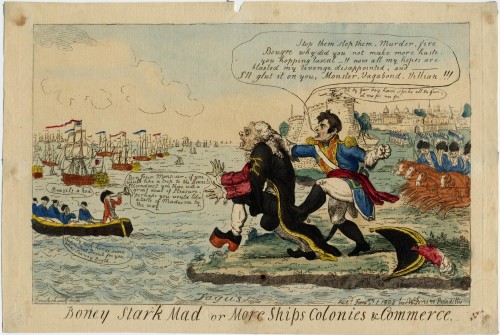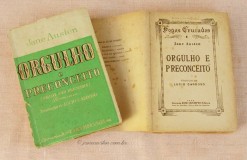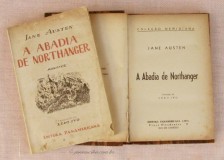It is very likely that Jane Austen continued to see Northanger Abbey in large part as a satire of gothic literature even if she also touched on different issues. When she prepared the manuscript to be published, thirteen years after her first attempt, she wrote an advertisement cautioning readers that those years “have made comparatively obsolete” some parts of the work since “during that period, places, manners, books, and opinions have undergone considerable changes” (1). Austen was acknowledging that gothic novels had lost most of their appeal since the time when Ann Radcliffe was making Henry Tilney’s hair stand on end, and her alert indicates her worry that, even if most readers could still understand Northanger Abbey’s references, much of the wit of the novel would be lost and appear, instead, old-fashioned. This may be the reason why Austen was unsure about publishing “Catherine,” which, she said, she had “put upon the shelve” and did not know that it “will ever come out” (13 March 1817).
Austen’s words in the advertisement are also relevant in regard to the reception of her novel today. In fact, there is a chance that her concern is actually more valid now than when Northanger Abbey was published, since most of her fans nowadays do not read the novels preferred by Catherine, Isabella Thorpe, and Mr. Tilney. Her remarks, then, inspire a question: is the knowledge of the satirized material a necessary condition for the enjoyment of the satire? Or, if current readers cannot recognize and share the humor in this novel, in what ways, then, are they reading it? These questions were also insistent throughout my study of Austen’s reception in Brazil, where Northanger Abbey was not published until 1944. If we never had medieval castles nor ruined abbeys there, if the mountains and forests in Italy were very far away and very different from our tropical landscape, and if gothic literature was more than a century out of popularity, how might the understanding of Northanger Abbey be influenced by such different historical, geographical, and literary contexts?
To try to answer these questions, this essay is divided in three parts: first, the arrival of British fiction—and Jane Austen—in Brazil; second, her translations to Portuguese in the nineteenth and twentieth centuries; and, finally, the gothic in Brazil, the development of a literary subgenre called “Tropical Gothic,” and the reception of Northanger Abbey today.
British fiction across the South Atlantic
When we think about Napoleon Bonaparte and Jane Austen, the usual links between Persuasion’s naval characters and the war against France come to mind, or even the militia quartered in Meryton as a reminder of the danger of an invasion. What many do not know, however, is that Bonaparte is also the beginning of the story of how Austen ended up in Brazil in the nineteenth century. Sometimes directly from England, or in an indirect way through Paris and Lisbon, Austen arrived in the tropics along with Daniel Defoe, Walter Scott, Maria Edgeworth, Ann Radcliffe, and many more.
This story begins in 1807, when the Portuguese Prince Regent, Dom João VI, faced a very difficult choice: he was ordered by Napoleon to quit all trading with Britain as part of the French emperor’s plan of financially asphyxiating his enemy. Portugal’s ports were to close to English ships, Englishmen were to be arrested, and their properties confiscated. Dom João, however, could not easily obey the command, even with the threat of a French/Spanish invasion and the loss of his throne, because Portugal’s economy was closely dependent on commerce with England. Apart from that, the British Foreign Secretary George Canning also stated that he would tolerate the closing of Portugal’s ports (while negotiating the opening of Brazil’s ports to England instead), but anything else would be looked upon as a declaration of war. Therefore, if Dom João accepted Napoleon’s command, his country would be bankrupted and bombarded; if he didn’t, it would be invaded and his House would be taken down. What was there to do? The answer was an old idea recycled with the support of England: to remove the whole Portuguese Court to Brazil, their colony in South America, establishing there a new capital for a (future) united kingdom of Portugal and Brazil. Dom João, his family, counsellors, ministers, nobility, their belongings, treasury, official documents, in other words, the whole institution of the Portuguese monarchy (including the royal library, which was forgotten in boxes by the port and sent over afterwards), were chaotically embarked on November 27, 1807, to flee the danger in thirty-six English ships, commanded by the famous Sir Sidney Smith. They set sail on November 29—just in time: Napoleon’s army entered Lisbon, led by General Junot, on that same day (Schwarcz and Starling 159–68).

A British soldier mocks Bonaparte, inviting him to Brazil. “Stark Mad” at General Junot (in black) for arriving too late in Lisbon, Boney yells, “Stop them!” (1808)
(Click here to see a larger version.)
The royal family reached Salvador after fifty-four days and then moved on to Rio de Janeiro, arriving on March 8, 1808. Dom João’s first decree in the new land was to open the Brazilian ports to “friendly nations,” mainly England, whose traders didn’t lose any time bringing their merchandise to Brazil, especially since Lisbon was now under French siege and could not supply the needs of the former colony. Among chinaware, cutlery, and even ice skates, English ships also brought, yes!, novels. But there remained one impediment: the language. The French language was much more au courant than English among the local elite, being associated with civilization, high culture, and fashion, and the result is that reading material in English was not as abundant as the titles in Portuguese and French available in circulating libraries and bookshops in Rio de Janeiro in the first half of the nineteenth century.
There was, however, one exception: the Rio de Janeiro British Subscription Library, a combination circulating library and men’s club, founded in 1826, where British citizens residing in Brazil (military, diplomats, traders, missionaries, et al.) could get together, socialize according to familiar rituals, and read books and weeks-old newspapers from home, all for a small subscription fee. In their statutes, there was a specific article stating that all reading materials bought by the Library should be in English (Schapochnik 89), indicating perhaps at least some difficulty in finding them elsewhere. In his study of this kind of circulating library in Brazil, Nelson Schapochnik was able to locate a catalogue from 1842,1 in which the category “Works of Fiction” (mostly novels) covered more than a quarter of all the books available, with titles from England and North America and occasional translated works such as The Sorrows of Werther and Don Quixote (99). Schapochnik also mentions in a second catalogue, from 1882, five works by Jane Austen. Sandra Vasconcelos traced probably the same five works to a previous version, the 1864 catalogue, adding precious information about their editions:
“Emma: A novel.” London: John Murray, 1816. 3 vol.
“Mansfield Park: A novel. In three volumes. By the author of ‘Sense and Sensibility’ and ‘Pride and Prejudice.’” London: T. Egerton, 1814, 3 vol.
“Northanger Abbey: and Persuasion by the author of ‘Pride and Prejudice,’ ‘Mansfield Park,’ etc., with a biographical notice of the author, in four volumes.” London: John Murray, 1818. 4 vol.
“Pride and Prejudice: A novel. In three volumes. By the author of ‘Sense and Sensibility.’” London: T. Egerton, 1813, 3 vol.
“Sense and Sensibility: A novel. In three volumes. By a Lady.” London: T. Egerton, 1811, 3 vol.2
Unfortunately, there was no information regarding acquisitions in the catalogue, but it is worth noting that these books, listed in 1864, were not the Bentley editions or subsequent ones but the Thomas Egerton and John Murray editions published during Austen’s own lifetime and soon after her death. More astonishingly, in the cases of Sense and Sensibility, Pride and Prejudice, and Mansfield Park, this little library in Brazil actually held the first sold-out editions. We can’t be sure when they arrived in the Library, but we know now that Austen’s complete published work has been available in Brazil for a long time, even if to a reduced reading public.
Did the first wave of Austenmania, following the publication in 1870 of James Edward Austen-Leigh’s A Memoir of Jane Austen arrive in Brazil as well? That question needs further research to be answered. So far, literary historians have not been able to locate the lost collection of books once belonging to the Rio de Janeiro British Subscription Library, closed in 1888. Maybe they were divided among members, maybe they were donated to other institutions or rest to this day in private collections of rare books.
In the Library’s 1882 catalogue there are also references to many titles popular in that period in England and, likely because of that popularity, brought to Brazil. Charles Dickens, Anthony Trollope, and Walter Scott are the authors with the highest number of works available (35, 29 and 28 respectively), but, according to Schapochnik, we can find several examples of all subgenres of the novel as well: historical (Edward Bulwer-Lytton), social (Elizabeth Gaskell, Harriet Beecher Stowe3), realistic (George Eliot), detective (Wilkie Collins), and gothic (William H. Ainsworth). This reading material available overseas closely followed the popular taste in Europe throughout the nineteenth century, challenging the common belief that cultural life across the Atlantic was necessarily behindhand (Vasconcelos, “Cruzando” 363).
Those authors’ prominence also made them likely items in catalogues from other subscriptions libraries in Rio de Janeiro, such as the Gesellschaft Germania (founded in 1821) and the Gabinete Português de Leitura (founded by the Portuguese in 1837). For example, the Portuguese library had 24 works by Walter Scott (20 translated to Portuguese, 2 in Spanish, and 2 in French), and 12 works by Charles Dickens (8 in English, 1 in Portuguese, and 3 in French) (Schapochnik 104). Another name that consistently appears in other libraries in Rio de Janeiro is Ann Radcliffe, though always translated to French or Portuguese. The exception, again, was the British Subscription Library, with one copy of The Mysteries of Udolpho and one of The Romance of the Forest, both from Anna Letitia Barbauld’s 1820 “British Novelists” collection (Vasconcelos, Caminhos). Its members who read Northanger Abbey, therefore, would have the means to know what Austen was satirizing.
Austen translated in Brazil
The relative distinction of the French language among the Brazilian elite, as mentioned above, explains the local demand for fiction written or translated either into French or Portuguese, to the detriment of English. It was in an 1858 catalogue of that same Gabinete Português de Leitura that Sandra Vasconcelos discovered the first Portuguese translation of Austen available in Brazil. The title, A família Elliot, ou A inclinação antiga (The Elliot family, or The Ancient Inclination), wouldn’t be easily recognized as a translation of Persuasion since there was no reference in the catalogue to the author, only that it was translated from French by a certain M.P.C.C. d’A and published in Lisbon in 1847.4 Apart from this library in Rio, whose copy of A família Elliot is now lost, there was also one copy in the Gabinete Português de Leitura do Pará, in the far north of the country, and one in the Biblioteca Rio-Grandense, in the south, both surviving to this day (Vasconcelos, “Circuitos” 152).5
A família Elliot is relevant not only because it was the first Portuguese translation of Austen (Lopes 48) but because it was translated from a French version by Madame Isabelle de Montolieu, the first person to fully translate Austen into that language. Hers is the title La Famille Elliot, ou L’Ancienne Inclination; Arthur Bertrand published her translation in Paris in 1821. Many studies have shown how Mme. Montolieu was not concerned with the modern concept of fidelity to the original (Dow, 161), and worked to adapt Austen to the French taste—which, at that time, meant sentimentality, elevated language, the effusion of feelings, tears, swoons, and sighs. Isabelle Bour argues that Montolieu, “[a]s a practitioner of the novel of sensibility . . . must have felt that Austen was too unromantic” (22) and so, in her translation of Sense and Sensibility (Raison et sensibilité [1815]), for example, added several new scenes and made considerable changes to enhance the sentimentality of the novel.
Montolieu’s version of Persuasion, which tells the story of Alice [Anne] Elliot and Fréderich Wentworth, is seen by Bour as more faithful to the original than her Sense and Sensibility, but it is still “a free translation, which involves a good deal of heightening, explication and trivializing” (27), with situations made more dramatic and with “lapses into bathos and the most hackneyed sentimental language” (29). Even with all these changes, Bour concludes that La Famille Elliot, unlike Montolieu’s Raison et sensibilité, does not reshape Austen’s work into a different genre, that of the sentimental novel (32). Even if we concede the case, however, one can still argue that Montolieu’s changes and additions did produce a new text highly different from Austen’s, and Montolieu’s was the text translated to Portuguese.6 So, if we disregard the British Subscription Library’s volumes, Austen was first made available to Brazilians not as herself but as the kind of author that she loved to mock in her juvenilia. The irony would not have been lost on her.
Austen’s case was not an exception. For decades, Brazilian literary critics only saw the major impact French writers had on the development of Brazilian literature, placing works from other languages as secondary. It is true that, as soon as Napoleon was defeated, France regained its cultural prestige, and its language remained as a symbol of education and refinement for the local elite. Examining catalogues from libraries and bookshops’ advertisements from nineteenth-century Rio, however, Vasconcelos showed that many titles in French or in Portuguese with the notice “translated from the French” on their covers were actually British novels. They arrived in Brazil through a winding path from London to Paris, where they were translated to French, then moved from Paris to Rio de Janeiro; or they moved to Lisbon, where they were translated to Portuguese, and then to Rio. In the newspaper Gazeta to Rio de Janeiro, Vasconcelos found advertisements “announcing ‘very modern and entertaining novels’” in Portuguese, such as Elizabeth Helme’s Luiza, ou o cazal no bosque (21 September 1816), Swift’s Viagens de Guliver (15 March 1817), Defoe’s Vida e Aventuras Admiráveis de Robinson Crusoe (9 April 1817), Fielding’s Tom Jones, ou o Engeitado (10 May 1817), and Richardson’s História da Infeliz Clarissa Harlowe (8 March 1820). According to Vasconcelos, “everything seems to indicate that these are the first British fictional works to have circulated in Brazil” (“Migratory Literary Forms” 73).
As was the case with A Família Elliot, most works that went through this double process of translation were modified to attend to the demands of French readers, and, when they arrived in Brazil, helped to create a taste for a specific kind of novel, the romance-folhetim, serialized stories published in newspapers, which would become highly popular in Brazil. As Vasconcelos observed, “the formula is not at all different from the one found in popular British fiction: kidnapping, treachery, dishonor, virtue in distress, terrible villains, seduced and abandoned heroines, all combined with the realistic painting of scenes of everyday life, the valorization of domestic space, and the new role of women in the bourgeois family” (“Migratory” 78). This taste remains to this day: Marlyse Meyer, for example, has recognized the similarities between the folhetim and Brazilian soap operas. In 2018, the TV channel Globo broadcast a six-month-long soap opera called Orgulho e Paixão (Pride and Passion), based on Austen’s novels7 while following that formula almost to the letter. Orgulho e Paixão is the most recent outcome of the current Austenmania that has been reshaping Austen away from her satirical and ironical tone, in a process similar to the alterations observed in A Família Elliot.
It would take the success of the 1940 Pride and Prejudice movie to promote new translations of Austen to Portuguese in Brazil.8 José Olympio’s company published Orgulho e Preconceito in 1940 (with a reference in the front flap to the movie), Mansfield Park in 1942, and Razão e Sentimento in 1944 (Brião). In 1944 another company, Panamericana, published A Abadia de Northanger. Persuasion was not translated until 1971; Emma was translated in 1996, probably due to the interest rekindled by the new movie and TV adaptations of that decade, including two Emma films from that same year.
 |
 |
|
|
The first Brazilian editions of Orgulho e Preconceito (1940) and A Abadia de Northanger (1944). Collection of Raquel Brião. |
||
Renowned Brazilian novelists and translators worked on these editions, with an opposite approach from Mme. Montolieu’s in the case of A Família Elliot. Even their effort to capture Austen’s style of writing, however, was not enough to dispel the perception that Austen is, after all, a romantic and sweet writer. This perception is associated not only with the present-day Austenmania, instigated in Brazil by the 2005 Pride and Prejudice with Keira Knightley, but also by our never-abandoned taste for the melodramatic (once again, I refer to our culture of soap operas). It is likely that readers saw then (and continue to see now) what they wanted to see in her works, effecting an adjustment of Austen according to that genre, which, in its turn, led to her becoming an obvious source for a soap opera.
Tropical Gothic: what about Northanger Abbey?
New legions of Brazilian Austen fans, assembled at the Facebook page “Jane Austen Society of Brazil,” spend many hours discussing the novels and adaptations, but one theme is recurrent: the love plots with, as consequence, the heroes. Northanger Abbey gains points because of Henry Tilney: he knows his muslin, after all. A review of comments posted on that online community shows that Northanger Abbey is usually the last to be discovered by new admirers of Austen, who tend to disregard the gothic parody when searching for similarities between this story and their favorites, namely Pride and Prejudice or Persuasion (in other words, Mr. Darcy and Captain Wentworth). The 2007 adaptation of Northanger Abbey, starring Felicity Jones and J. J. Feild, facilitates this process since Andrew Davies’s screenplay highlights romance and sexual attraction.
The posts written by Brazilian fans about Northanger Abbey point to divergences in this novel from what they considered “standard” Austen. One person described the novel as “cute,” “lighter and more naïve than Sense and Sensibility or Pride and Prejudice” (Belloube). Another states that Tilney is an upgraded version of Darcy because, “apart from being charming and having a good heart, he possesses a wonderful sense of humor”; in addition, he has a cool sister, is a good dancer, likes to read novels, and knows about fabrics. But, above all, clearly idealizing the character, this fan concludes, “Tilney did not betray or hurt his heroine in any moment and loved her with her limitations and imperfections” (Petrucci). This community of Austen’s Brazilian admirers would not wholly agree with the narrator of Austenland: “Jane [Hayes] had first read Pride and Prejudice when she was sixteen, read it a dozen times since, and read the other Austen novels at least twice, except Northanger Abbey (of course).” (Hale 2, my emphasis). Overall, however, the relative dearth of posts regarding Northanger Abbey attests that this novel is far from being a favorite in the community.
To understand Northanger Abbey’s comparative lack of popularity among fans in Brazil, one must remember the power of the hype that surrounds Pride and Prejudice and that makes it the entry into the wonders of the Austen world, the story to be topped. Darcymania has been working at full strength in Brazil, and Captain Wentworth’s love letter is the only thing that can overthrow Darcy’s appeal. Another hypothesis, however, lies in the novel itself and the gothic parody, which may actually hinder readers’ appreciation for either a joke they don’t get or something very different from the “standard Austen” they expect. Either way, this hypothesis leads necessarily to a search for the gothic novel in Brazil.
As mentioned earlier, many British novels, including Ann Radcliffe and other names associated with the gothic, such as Horace Walpole, arrived in Brazil through a French-Portuguese translation system. The most important author in Brazilian literature, Machado de Assis, translated Edgar Allan Poe’s “The Raven,” a seminal text of the North American gothic. If we consider only the catalogues of bookstores and libraries, it is difficult to determine which novels people were actually reading, but there are alternative sources, such as references in the fiction of that time (what characters read) and in memoirs. For example, another important Brazilian novelist José de Alencar (1829–1877) registered the influence of this kind of literature on his path to becoming a writer. One of his first models was, in his words, a kind of melancholic novel, “full of mysteries and frights. . . . In it the scene began in the ruins of a castle, wrapped in a shroud of a weak moonlight; or in a small gothic chapel poorly lit by a lamp, whose light reflected on a tombstone” (my translation).
Daniel Serravalle de Sá argues not only that the literate people in Brazil had access to this traditional “gothic canon” evoked in Alencar’s memoir but also that its tropes made their way into Brazilian fiction writing. He analyzed Alencar’s classic work O Guarani (1857) and identified how the author recast particular key elements of the gothic, such as forests and mountains, castles, and typical characters, to match Brazil’s nature and history. Alencar uses the tropical jungle as the source of the sublime, the colonial period as the distant past, a native man (Peri, the Guarani from the title) as the hero with chivalrous medieval traits, and Cecilia, the daughter of a Portuguese nobleman, as the angelic white heroine for whom Peri feels almost a courtly love (Sá 20–23). O Guarani however, is not an automatic transposition. One look at the ending is enough to understand why: after Cecilia’s family dies, Peri saves her, and they leave together to begin a new life, almost as an inter-racial Brazilian Adam and Eve, which shows just how much Alencar was able to use elements of the gothic (and of other genres) to raise politically imbued questions about his own country. Peri’s baptism just before the final tragedy reconfigures his origins into a safe frame, but his pairing with Cecilia remains an open question for a nation that has not been able to deal with its multi-ethnicism except through violence.
Daniel Sá calls Alencar’s appropriation “Tropical Gothic,” a term that has been used in academic studies to indicate a transculturation process through which, as Edwards and Vasconcelos put it, the colonized subject transforms, appropriates, adapts, and re-writes the modes and genres of the North Atlantic, “revising models for articulating local experience and culture in the American tropics” (1). Gabriel Elkaiek-Rodriguez, in his turn, argues that this “tropicalization” of the gothic, continuing to this day in contemporary literature and cinema, “revives Gothic images and themes” but, most importantly, “employs images and imaginaries . . . that situate extreme otherness and monstrosity in the southern part of the continent” (14). In this new subgenre, the European images associated with the tropics as either a paradise lost or a hell of savages, diseases, and lust are reconfigured and combined with local folklore: “sunlit and humid conditions form a hotbed where Gothic figures—ghosts, zombies, vampires—move freely through plantations, houses and tropical cities, haunting the bright landscape and forming the basis for tropical chills” (Edwards and Vasconcelos 2). Several Brazilian writers, since Alencar, have appropriated the gothic to discuss painful topics that were consistently avoided in the creation of a “united” nation post-independence, such as the slavery of Africans or the extreme poverty in the dry backcountries of the Northeast (Julio França 118).
The Tropical Gothic also appropriates a social critique already present in the “original” gothic. Many critics have observed politically charged passages in the works of Ann Radcliffe, for example, indicating that the genre was not only about the horrors—or, instead, that the horrors actually played a more significant role than just raising the hairs on the back of a reader’s neck. Austen must have been aware of this complexity when she wrote Mr. Tilney’s comment on the absurdity of Catherine’s imaginings: “‘Remember that we are English’” (203). This sentence has a double significance only understood at the end of the novel. At first, it can be read as if Austen were reinforcing English identity in a positive light, something that gothic novels usually did, albeit in a reverse way, when they defined Englishness by contrast to what it was not. When we reach the final chapters of the novel, however, that sentence returns to haunt readers and probably, after he learns what his father has done to Catherine, Henry Tilney also. Austen suggests that we go back to his admonition and question not only Tilney’s supposed superiority but also that English identity he is so proud and sure of. Even if they were English, and even if they were Christians, there were still people of very low character such as General Tilney and the Thorpe siblings. When Latin American writers used the tropes of the gothic to question their own nations’ self-image, therefore, they were “tropicalizing” an artistic approach to politics present since the beginning of the genre.
![]()
How does this notion of the Tropical Gothic help us understand Northanger Abbey’s reception in Brazil? We know that the gothic novels from the end of the eighteenth century and the first half of the nineteenth were indeed available there, but not concomitantly with Austen’s novel (the British Subscription Library’s volumes being an exception, though limited to its members). Northanger Abbey was first translated in Brazil in 1944, long after those translations of Radcliffe were forgotten by the popular taste; therefore, those first Brazilian readers of Northanger Abbey probably didn’t know the specific reference of the parody, only the more recent branches of the gothic, such as horror literature and film. Furthermore, even if Brazilian readers were familiar with many cases of the Tropical Gothic, Austen’s overt satire would be more easily recognized as a dialogue with that historical literary genre from England in the last quarter of the eighteenth century. The process of tropicalization produced works too distant to be immediately acknowledged as gothic—the parallel between the villain’s real plan to kidnap Cecilia from O Guarani and Catherine’s fantastic suspicions about Mrs. Tilney is indeed a distant one. Reading a satire may not be as fun if we are not in on the joke.
It is not surprising, then, that Brazilian fans of Austen, when discussing Northanger Abbey, do not focus on the gothic. Their understanding of Austen is deeply associated with the tropes of another subgenre, the romance (Harlequin novels are highly popular in Brazil), and it becomes a sort of looking glass through which they read Austen’s work. This looking glass allows readers to see the aspects they were already expecting to find—the love plot, the courtship and its obstacles, etc.—and obliterates what does not fit into their expectations. The fact that Henry Tilney is so positively evaluated as a romantic hero (again, I must insist on the effect of the 2007 movie on this image) is probably the most important reason why Northanger Abbey is seen as more than tolerable, and why many Brazilians were tempted to read it.
NOTES
1The catalogue was published by the Smith & Elder company, which acted as the Library’s agent in England in sending over books and other materials to Brazil, and which was also the publisher of novelists such as Charlotte Brontë and William Thackeray.
2Professor Sandra Guardini Teixeira Vasconcelos from the University of São Paulo personally made this information available to me while her research is under preparation for publication. An initial list is available at the project “Caminhos do Romance” website: http://www.caminhosdoromance.iel.unicamp.br/ > cronologias > ficção inglesa
3The reference to the U.S. writer Harriet Beecher Stowe is a particularly interesting one, since slavery in Brazil was only abolished in 1888. Slavery was a sore point in foreign relations between the now-independent Brazil (since 1822) and the British Empire, which was pushing for the end of the slave trade—one of the reasons why locals maintained a dubious opinion regarding Englishmen and, as a consequence, their language and culture. It is not surprising that many British citizens, who supported abolition and often registered their discomfort with the slave market, flogging, and other cruel treatments they witnessed daily in Rio, would welcome Stowe’s works (see Jean França).
4The initials refer to Manuel Pinto Coelho Cota (or Cotta) de Araújo, who also translated works by Ann Radcliffe and Walter Scott.
5Although I refer to Vasconcelos’s 2016 essay in Portuguese, there is a version in English available: “Circuits and Crossings: The Case of A Família Elliot” in The Transatlantic Circulation of Novels Between Europe and Brazil, 1789–1914, ed. Márcia Abreu (London: Palgrave Macmillan, 2017), 125–44.
6Gillian Dow (161) also notes that Montolieu’s La Famille Elliot was the basis for an 1836 Swedish translation, Familjen Elliot, which, according to Anthony Mandal, was a watered-down version of the original that “sits more comfortably with contemporary Swedish expectations of British fiction than with Austen’s original itself” (5).
7The main plot was taken from Pride and Prejudice, focusing on a family, the Beneditos, with five unmarried daughters. While Jane, Elizabeth, and Lydia Benedito follow, more or less, the path of the original novel, Mary was replaced with Mariana (Marianne Dashwood), and Kitty was replaced with Cecilia, a reference to Catherine Morland. There are other characters inspired by Emma, Lady Susan, Lady Catherine, Mr. Willoughby, Colonel Brandon, et al. The hero is, of course, Mr. Darcy.
8Portugal published its modern translations in this decade as well, so, with the exception of Emma and Persuasion they could not have arrived in Brazil long before the publication of the first Brazilian translations. Alexandra Lopes makes an interesting argument that this first “wave” of translations in Portugal between 1940 and 1960 follows an attempt to sentimentalize Austen and sell her as a writer of romantic novels, as, for example, with the inclusion of a 1943 edition of A Abadia de Northanger in the collection “Biblioteca das Raparigas” (The young women’s library) (Lopes 49–50). Further research is necessary to see if the same approach can be identified in the Brazilian translations of the same period.






